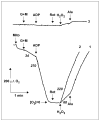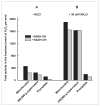What are the sources of hydrogen peroxide production by heart mitochondria?
- PMID: 20170624
- PMCID: PMC2891298
- DOI: 10.1016/j.bbabio.2010.02.013
What are the sources of hydrogen peroxide production by heart mitochondria?
Abstract
Coupled rat heart mitochondria produce externally hydrogen peroxide at the rates which correspond to about 0.8 and 0.3% of the total oxygen consumption at State 4 with succinate and glutamate plus malate as the respiratory substrates, respectively. Stimulation of the respiratory activities by ADP (State 4-State 3 transition) decreases the succinate- and glutamate plus malate-supported H2O2 production 8- and 1.3-times, respectively. NH4+ strongly stimulates hydrogen peroxide formation with either substrate without any effect on State 4 and/or State 3 respiration. Rotenone-treated, alamethicin-permeabilized mitochondria catalyze NADH-supported H2O2 production at a rate about 10-fold higher than that seen in intact mitochondria under optimal (State 4 succinate-supported respiration in the presence of ammonium chloride) conditions. NADH-supported hydrogen peroxide production by the rotenone-treated mitochondria devoid of a permeability barrier for H2O2 diffusion by alamethicin treatment are only partially (approximately 50%) sensitive to the Complex I NADH binding site-specific inhibitor, NADH-OH. The residual activity is strongly (approximately 6-fold) stimulated by ammonium chloride. NAD+ inhibits both Complex I-mediated and ammonium-stimulated H2O2 production. In the absence of stimulatory ammonium about half of the total NADH-supported hydrogen peroxide production is catalyzed by Complex I. In the presence of ammonium about 90% of the total hydrogen peroxide production is catalyzed by matrix located, ammonium-dependent enzyme(s).
Copyright © 2010 Elsevier B.V. All rights reserved.
Figures


References
-
- Chance B, Williams GR. The respiratory chain and oxidative phosphorylation. Adv Enzymol Relat Subj Biochem. 1956;17:65–134. - PubMed
-
- Jensen PK. Antimycin-insensitive oxidation of succinate and reduced nicotinamide-adenine dinucleotide in electron-transport particles. Biochim Biophys Acta. 1966;122:157–166. - PubMed
-
- Hinkle PC, Butow RA, Racker E, Chance B. Partial resolution of the enzymes catalyzing oxidative phosphorylation. XV. Reverse electron transfer in the flavin-cytochrome b region of the respiratory chain of beef heart submitochondrial particles. J Biol Chem. 1967;242:5169–5173. - PubMed
Publication types
MeSH terms
Substances
Grants and funding
LinkOut - more resources
Full Text Sources

